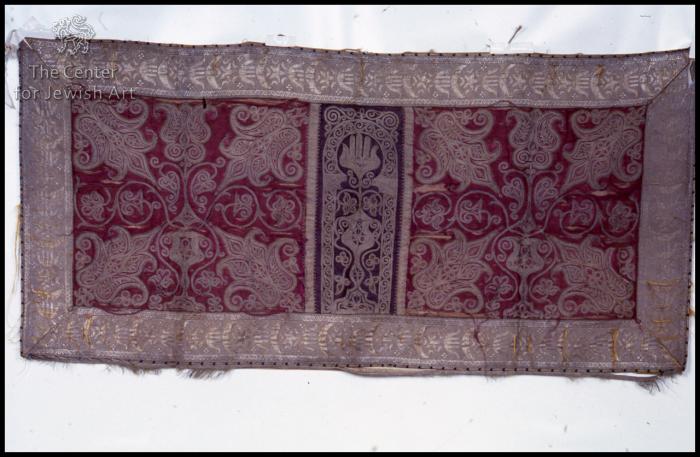Img. ID: 255736

The rectangular purple Torah case wrapper is divided into a central vertical rectangle flanked by two square panels (see: Remarks: no. 1).
The central panel is adorned with an arch enclosing an open hand (hamsa) set on top of a vertical scrolling stem.
The side panels are identically decorated with a symmetrical pattern, depicting a vase from which stem four fleur-de-lis set at each of the corners and point towards the centre. Each fleur-de-lis is enfolding pointed leaves, which form each flower. Scrolls and an additional flower are set in between the flowers.
The wrapper is framed with a strip decorated with a pattern of open hands (hamsa), crescents (hilal), stars and flowers.
Ten hooks for hanging the wrapper on the Torah case are attached to its upper edge, while a strip of fringes is attached to its bottom.
|
Fig. 1. Torah case wrapper, Libya, end of the 19th century |
Fig.2. Torah case wrapper, Tunisia, end of the 19th century, Sc.92-23 |
Cloth: silk purple velvet
Lining: linen in tabby
Decoration: silver threads in laid and couched embroidery
Foundation: cotton
Inscription: silver threads in laid and couched embroidery
Foundation: cotton
Additions: industrial strip of wound gold and silver threads, fringes
Hamsa
1. The composition of the embroidery is adjusted to the Torah case on which the wrapper is suspended. The rectangular central panel is parallel to the back facet, which is usually separated from the side units and attached to each half of the case by hinges.
2. This professional metal-thread embroidery was made by skilled men in Tunisia and Libya, and to a lesser extent by skilled women.. Most embroideries were of traditional costumes, in which the most relevant to the Torah wrappers was the waistcoat (fremla) worn by the bride during the wedding ceremony. The characteristics of the traditional costumes vary from one area to another as is the embroidery. For example, the Meiden embroidery is less condensed and features birds and flowers, while the mountain villagers of the south adorn their elegant draped dresses with geometrical patterns. The strips are of French origin especially made for the North African customers (Yaniv, The Torah, 1997, p. 119, note 43; for similar wrappers, see: Sc.92-23).



